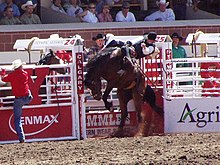
Rodeo is a competitive equestrian sport that arose out of the working practices of cattle herding in Spain and Mexico, expanding throughout the Americas and to other nations. It was originally based on the skills required of the working vaqueros and later, cowboys, in what today is the western United States, western Canada, and northern Mexico. Today, it is a sporting event that involves horses and other livestock, designed to test the skill and speed of the cowboys and cowgirls. American-style professional rodeos generally comprise the following events: tie-down roping, team roping, steer wrestling, Steer roping, saddle bronc riding, bareback bronc riding, bull riding and barrel racing. The events are divided into two basic categories: the rough stock events and the timed events. Depending on sanctioning organization and region, other events such as breakaway roping, goat tying, and pole bending may also be a part of some rodeos. The "world's first public cowboy contest" was held on July 4, 1883, in Pecos, Texas, between cattle driver Trav Windham and roper Morg Livingston.

Bronc riding, either bareback bronc or saddle bronc competition, is a rodeo event that involves a rodeo participant riding a bucking horse that attempts to throw or buck off the rider. Originally based on the necessary buck breaking skills of a working cowboy, the event is now a highly stylized competition that utilizes horses that often are specially bred for strength, agility, and bucking ability. It is recognized by the main rodeo organizations such as the Professional Rodeo Cowboys Association (PRCA) and the International Professional Rodeo Association (IPRA).

Rodeos have long been a popular competitor and spectator sport in Australia, but were not run on an organised basis until the 1880s.
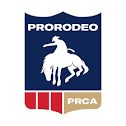
The Professional Rodeo Cowboys Association (PRCA) is the largest rodeo organization in the world. It sanctions events in the United States, Canada, and Mexico, with members from said countries, as well as others. Its championship event is the National Finals Rodeo (NFR). The PRCA is headquartered in Colorado Springs, Colorado, United States.
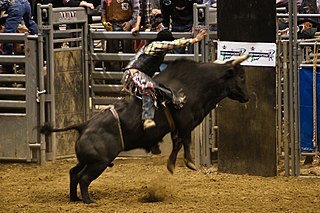
The ProRodeo Hall of Fame and Museum of the American Cowboy was opened in August 1979 as a museum designed to "preserve the legacy of the cowboy contests, the heritage and culture of those original competitions, and the champions of the past, present and future." It is located in Colorado Springs, Colorado, and only inducts Professional Rodeo Cowboys Association and Women's Professional Rodeo Association members. It is the "only museum in the world devoted exclusively to the sport of professional rodeo."
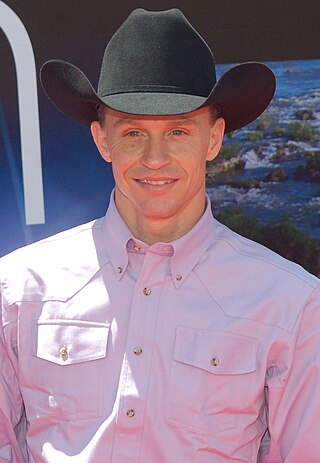
Ty Monroe Murray, is an American nine-time World Champion professional rodeo cowboy. He was one of the top rodeo contestants in the world from the late 1980s to early 2000s. He is one of the co-founders and a board adviser of the Professional Bull Riders (PBR). From 2005 to 2020, he was also a regular color commentator for several televised PBR events.

A mechanical bull, also known as a bucking machine, is a device that replicates the sensation of riding a bucking animal, such as a rodeo bull or horse, popularized by Sherwood Cryer. It is usually powered by a variable-speed electric motor. Padded flooring is often installed around the equipment in order to reduce the likelihood of injury to those thrown off it.
Lewis Feild was an American professional rodeo cowboy. He specialized in bareback bronc riding and saddle bronc riding and competed on the Professional Rodeo Cowboys Association (PRCA) circuit. He was the World All-Around Cowboy Champion from 1985 to 1987 at the National Finals Rodeo (NFR). He was also the World Bareback Riding Champion from 1985 to 1986. The ProRodeo Hall of Fame inducted him in 1992 in the all-around category.
The Miles City Bucking Horse Sale is a major auction of rodeo stock held the third full (two-day) weekend every May in Miles City, Montana, USA, and the premier social event for the community. Accompanied by a parade, a horse racing meet, a rodeo and a number of social activities, it attracts rodeo stock contractors from the United States and Canada who are looking for saddle bronc, bareback bronc and bucking bull prospects.
Reg Kesler began his rodeo career at the age of 14 at the Raymond Stampede, competing in the boys steer riding. At the time, it was common for cowboys to compete in many or even all the rodeo events, and Kesler was no exception as he grew into his rodeo career. He participated in all five major rodeo events of the time: saddle bronc riding, bareback riding, bull riding, tie-down roping and steer decorating, a precursor to steer wrestling. Kesler especially excelled in the roughstock events, namely saddle bronc riding and bareback riding, appearing in the top four in the Canadian standings in those events six times. He was also a successful competitor in the wild cow milking and wild horse racing, an outrider in the chuckwagon racing, and a well-known pick-up man. Kesler was a ProRodeo Hall of Fame and Canadian Pro Rodeo Hall of Fame inductee.
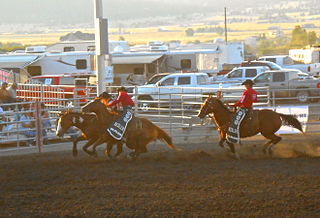
A pickup rider is a person on horseback who works at a rodeo in the rough stock competitions of bull riding, saddle bronc and bareback riding. Pickup riders play an important role in assisting rodeo riders and increasing the safety of competitors.

A stock contractor is an individual or business that provides animals for rodeo competition. Stock contractors supply roughstock - horses for saddle bronc and bareback bronc riding and bulls for the bull riding event, plus steers for steer wrestling and team roping, plus calves for calf roping events. Use of stock contractors who specialize in providing these animals has produced a more uniform range of bucking stock which are also quieter to handle.
The Heart of the North Rodeo is located in Spooner, Wisconsin, United States. The rodeo takes place the first full weekend in July every year since 1954, except 2020. It is sanctioned by the Professional Rodeo Cowboys Association (PRCA). Fans from all over come to watch the professional cowboys and cowgirls compete in the seven main events of rodeo, and even some up-and-coming little cowboys and cowgirls.
Three Bars was a Canadian rodeo bucking horse that was specialized in bareback bronc riding. She was the Bareback Horse of the National Finals Rodeo (NFR) three times in 1967, 1973, and 1980. She was inducted into the Canadian Pro Rodeo Hall of Fame of the Canadian Professional Rodeo Association (CPRA) in 1989, and the ProRodeo Hall of Fame of the Professional Rodeo Cowboys Association (PRCA) in 2004.

American Bucking Bull, Inc. (ABBI) is an organization dedicated to the registration of bucking bulls and establishing the American Bucking Bull as a documented breed of cattle. American Bucking Bull, Inc., is owned by the Professional Bull Riders (PBR) and stock contractors. The organization created a breed registry and manages the registration and certification of American Bucking Bulls. It also keeps records of other breeds of bulls, some of which died out many years ago. It is the largest organization performing these functions. It maintains a genetic DNA database, manages bucking bull pedigrees and encourages the growth of the breed. ABBI also holds competitions for bucking bulls ages 2 through 4. It also has its own magazine, the American Bucking Bull.

War Paint was a saddle bronc who was a three-time Rodeo Cowboys Association Bucking Horse of the Year. He won the award in 1956, 1957, and in 1958 he tied with another horse. He was inducted into four halls of fame, the most prominent being the ProRodeo Hall of Fame in 2011. War Paint was known for his bucking ability and his buck-off record, which was close to 90 percent.
Grated Coconut #G-65 (1997–2024) was a Canadian rodeo bucking horse that was specialized in bareback bronc riding. He was a six-time Professional Rodeo Cowboys Association (PRCA) Bareback Horse of the Year. He was also a six-time Canadian Professional Rodeo Association (CPRA) Bareback Horse of the Year from. He was inducted into three halls of fame, including the ProRodeo Hall of Fame of the PRCA, the Canadian Pro Rodeo Hall of Fame of the CPRA, and the Ellensburg Rodeo Hall of Fame of the PRCA-sanctioned Ellensburg Rodeo.
Virgil F13 is a rodeo bucking horse. He is specialized mainly in bareback bronc riding, but is sometimes used in saddle bronc riding. Although born in North Dakota, United States, he has lived most of his life in Alberta, Canada. Virgil is a two-time Professional Rodeo Cowboys Association (PRCA) Bareback Horse of the Year, as well as a two-time Canadian Professional Rodeo Association (CPRA) Bareback Bucking Horse of the Year. He won the award in both organizations in the same years; 2017 and 2018. He was also awarded the Bareback Horse of the Canadian Finals Rodeo (CFR) four times from 2015 to 2018, as well as the Bareback Horse of the National Finals Rodeo (NFR) in 2017. He is also the horse that was ridden for the highest-scored bareback ride in PRCA history, which occurred in 2022.
Medicine Woman #302 was an American rodeo bucking horse that specialized in saddle bronc riding. She competed in the Professional Rodeo Cowboys Association (PRCA) and was a four-time PRCA Saddle Bronc Horse of the Year. She won the award in 2011, 2014, 2015, and 2016. She also was the Saddle Bronc Horse of the National Finals Rodeo (NFR) in 2010 and 2015. In 2022, she was posthumously inducted into the ProRodeo Hall of Fame.
Dirty Jacket #474 is an American rodeo bucking horse that is specialized in saddle bronc riding. He competes in the Professional Rodeo Cowboys Association (PRCA) and won the 2014 and 2015 PRCA Bareback Horse of the Year award.

